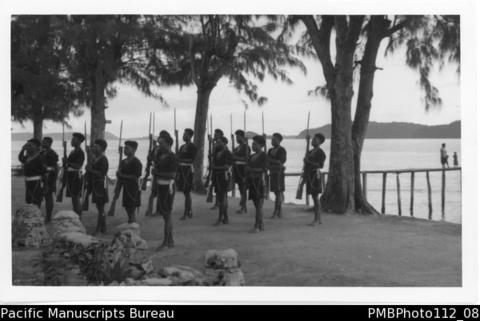Identity area
Reference code
AU PMB PHOTO 112-08
Title
Date(s)
- Dec 1949-Mar 1950 (Creation)
Level of description
Item
Extent and medium
1 digitised photograph
Context area
Name of creator
Biographical history
Frank Menzies Cameron Forster was born in Sydney, NSW, on 21 September 1923. He moved to Melbourne with his mother, Jean Catherine Forster, a psychology graduate and later pioneering remedial teacher, and attended Princes Hill Primary School then Melbourne Grammar. In 1940 Frank went to the University of Melbourne to study medicine. While there, he underwent surgery for a tumour on his spine which left him with “spinal weakness and intermittent pain.” He graduated with a Bachelor of Medicine, Bachelor of Surgery (MBBS) in 1948 with honours in surgery, obstetrics and gynaecology.
At the end of the following year, Frank spent the four months December 1949-March 1950 in the Australian Territory of Papua and New Guinea. Post World War 2, Australian health and medical professionals went to work there, but Frank did not stay there or return later as far as is known. He did keep a small collection of black and white photographs he took at the time which show that he visited Samarai, Lae, Goroka, Madang and Manus, travelling by boat and plane.
By 1951 he was a resident doctor at the Royal Women’s Hospital (RWH) in Melbourne. In 1952 he married Prudence Isobel Swan Edgar, a nurse, and in 1953 they travelled together to London where Forster worked at the Hospital for Women and gained membership of the Royal College of Obstetricians and Gynaecologists.
The Forsters returned by 1954 to Melbourne where Frank worked again at the RWH. He became known for his bedside teaching and lively lectures, emphasising the need for care of pregnant women, and became a specialist in dealing with difficult pregnancies. In 1967, he gave the inaugural annual Tracy Maund Memorial lecture, honouring the memory of the two founders of the RWH. Not only was Frank Forster a practitioner with a flair for teaching and public speaking, he was also a collector of medical books, pamphlets and instruments, a researcher, archivist and writer of works related to medical matters, and an active member and financial supporter of several organisations such as the Medical History Museum and the medical professional body known as the Royal Australian College of Gynaecologists (RACOG) and later as RANZCOG when the Australian and New Zealand bodies amalgamated. Frank donated to RACOG’s library his collections of items relating to women’s health in 1987. The College renamed their library the Frank Forster Library in his honour when Frank died on 18 March 1995 age 71. Frank was survived by his wife, a daughter and three sons.
More information about Frank Forster is online at http://adb.anu.edu.au/biography/forster-frank-menzies-23427. See also the article “A College Benefactor: Frank Forster” in Australian and New Zealand Journal of Obstetrics and Gynaecology 2004; 44: 3-5.)
Repository
Archival history
Immediate source of acquisition or transfer
Content and structure area
Scope and content
Appraisal, destruction and scheduling
Accruals
System of arrangement
Conditions of access and use area
Conditions governing access
Available for reference
Conditions governing reproduction
Language of material
Script of material
Language and script notes
Physical characteristics and technical requirements
Finding aids
Allied materials area
Existence and location of originals
Existence and location of copies
Access this title at PMB Member Libraries or by contacting the Bureau directly: http://asiapacific.anu.edu.au/pambu/accessing.php
Related units of description
Notes area
Note
Individual item titles are taken from supplied captions. The language is reflective of the period of captioning. Information added by cataloguer is included in square brackets [ ].
Alternative identifier(s)
Access points
Subject access points
Place access points
Name access points
- Forster, Frank (Subject)
Genre access points
Description control area
Description identifier
Institution identifier
Rules and/or conventions used
Dates of creation revision deletion
Language(s)
Script(s)
Sources
Digital object metadata
Filename
PMBPhoto112_08.jpg
Latitude
Longitude
Media type
Image
Mime-type
image/jpeg
